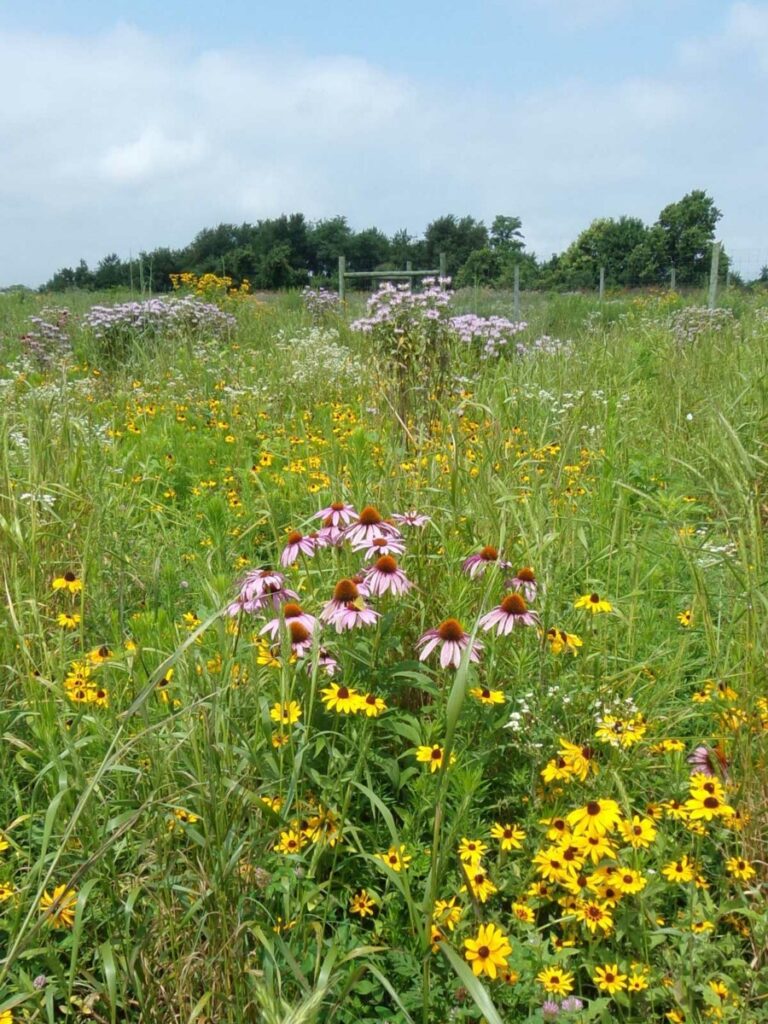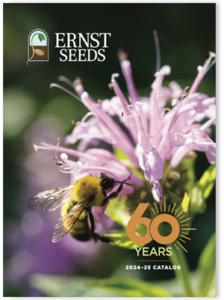Since before there were any humans around taking note of it, pollinators have played an invaluable role in maintaining the natural environment.
They’ve evolved alongside the native plant species they feed on and help pollinate, which means the two are so intertwined they cannot live without each other.
This codependency means that anyone interested in supporting pollinators like bees, butterflies, birds, and others must be aware of the importance of native seed mixes.
In this guide, we’ll cover:
· What makes a proper native pollinator seed mix.
· The best seed mixes and plants for east-coast landscapes.
· Some planting and maintenance tips for your meadow or project of any size.
First, you should understand the logic that goes into designing a native seed mix.
Understanding Pollinator Seed Mixes
Through generations of evolution, native pollinators and plants coevolved to support and rely on each other for habitat, nutrition, and reproduction. That’s why pollinator seed mixes prioritize native wildflowers and plants.
Guidelines for Creating Pollinator Seed Mixes
To support native pollinators, our seed mixes follow these guidelines from faculty at Penn State’s Center for Pollinator Research:
- There should be continuous bloom from as early to as late in the season as possible.
- At least three species should bloom each blooming season. These blooming seasons include late spring/early summer, summer, and fall.
- At least five plant families.
- The mix should include 26 species, though this may not always be possible due to the number of species appropriate to an area, deer pressure, or other factors.
- There should be host plants for specialist pollinators, e.g., Asclepias species (milkweeds) that support monarch butterflies.
Meeting the Specific Needs of East Coast Pollinators
When seed mixes are designed according to the guidelines above, meadows will have the ecological resilience required to thrive in the local climate. This ensures pollinators have access to essential nutrients.
For some pollinators, like butterflies and moths, native seed mixes contribute critical habitats for larvae. For example, monarch butterflies rely on milkweed plants to raise their larvae. The food source for the larvae of native bees is a combination of nectar and pollen produced by native plants. The nests of some species of native bees are located in the stems of native plants.
For bees in particular, a multitude of species is usually necessary for them to properly feed their larvae. To get the proper ratio of proteins to lipids, bees will visit and collect pollen from multiple species of native plants.
The Benefits of Pollinator Seed Mixes
By mimicking the diversity of native flowers found in natural environments, meadows planted with native seed mixes provide essential pollen sources for east-coast native pollinators. Among these pollinators are bees, beetles, butterflies, birds and moths, some of which are important pollinators of fruits and/or vegetables.
These pollinator meadow mixes also sustain and support the local ecosystem by attracting beneficial insects that control pests. Examples include Bicyrtes and Syrphid flies. Bicyrtes is a wasp that nectars on wildflowers then hunts for pests such as stink bugs to feed its larvae. The larvae of Syrphid flies complete their development in 2-3 weeks while consuming up to 400 aphids each.
Recommended Pollinator Seed Mixes for the East Coast
Those interested in seeding meadows, landscapes, or gardens in the east coast that are beneficial to pollinators can utilize these pollinator seed mixes from Ernst.
Each mix here has species that bloom from spring through the first frost, includes more than five plant families, contains more than three species that bloom each season, and contains milkweed for monarch butterflies.
- Showy Northeast Native Wildflower & Grass Mix: This mix is formulated for a visually attractive aesthetic that also supports a diverse pollinator community.
- Partially Shaded Area Roadside Mix: This mix is fine-tuned with grasses and forbs that thrive in roadside areas and woodland margins. It also contains both common milkweed and butterfly milkweed for monarchs.
- Mesic to Dry Native Pollinator Mix: This mix is designed for mesic to upland sites with full sun or light shade. It will attract a variety of pollinators and songbirds, and also contains butterfly, common, and swamp milkweed for monarchs.
Key Plants for East Coast Pollinator Seed Mixes
These key plants are present in all of the mixes above.
- Black Eyed Susan (Rudbeckia hirta): This is the earliest germinating wildflower in the mixes. By observing its easily recognized seedling, you can be sure that your meadow is germinating.
- Golden Alexanders (Zizia aurea): These contain bright yellow flowers and are the earliest-blooming herbaceous species we carry. Its early blooming, sometimes even before the snow has stopped falling, makes it a key early-season food source for pollinators.
- Tall White Beardtongue (Penstemon digitalis): With white flowers that bloom in late spring and early summer, this is one of our highest nectar yielding plants.
- Wild Bergamot (Monarda fistulosa): Another high nectar yielding plant. Wild bergamots bloom with purple flowers in mid-summer to early fall. Its mid to late summer bloom provides nectar during the summer dearth when many landscapes lack bloom.
- Mountain Mints (Pycnanthemum incanum, Pycnanthemum muticum, Pycnanthemum tenuifolium, and Pycnanthemum virginianum): These sweet-scented upland mint species attract a diverse range of pollinators and provide a high nectar yield. Their summer bloom also makes them a key food source during the summer dearth.
How to Plant and Maintain Pollinator Gardens
Meadows using native seeds typically don’t encounter major issues with insect pests and diseases. Instead, proper site maintenance and weed control should be your main focus.
Site Preparation & Planting
Planting starts with site preparation.
- Be sure to fully control all vegetation. Strategies like repeated tilling, smothering with black plastic, and herbicides, are effective.
- Always leave an appropriate time interval between any herbicide treatment and seeding. Some herbicide residues can prevent seedlings from germinating.
When it comes to planting:
- Many sites may be planted by drilling or broadcasting seeding. When seeds are broadcast on large sites, they should be firmed into the soil with a cultipacker or lawn roller. On small sites that have been broadcast planted, seeds should be gently raked into the soil with a garden rake or firmed into the soil by walking across it in two passes.
- For terrain where other seeding methods are not feasible, such as steep slopes, we recommend hydroseeding. When hydroseeding we recommend a two-step process where all seed is applied in the first pass with 500 lbs/acre of hydromulch. In a second pass an additional 1,000 lbs/acre of hydromulch is applied.
- In general, seeds will not germinate at a depth greater than twice their thickness.
Maintenance
During the first growing season:
- Keep an eye on canopy height. When it reaches knee height, trim the meadow to half knee height using a brush hog mower or string trimmer. Trimming reduces competition by fast-growing weeds for sunlight, water, and nutrients needed by slower growing perennial natives. Trimming should cease by mid-September.
- Problem weeds should be hand pulled or spot sprayed with an approved herbicide, such as Roundup®, Rodeo®, Garlon®, Garlon® 3A, Stinger®, or Milestone®.
In the second and subsequent growing seasons:
- Trim any remaining material from the previous year close to the ground before the new spring growth reaches 2”. This will allow the soil to warm more quickly, stimulating emergence and growth of native seedlings while reducing the likelihood of shrub invasion.
- Continue to monitor for and control problem weeds like bindweed, blackberry, multiflora rose, mile-a-minute, and Japanese hops. Take special note of hedgerows, along the forest edge, or along roadsides, where weeds often go uncontrolled.
- Be equally vigilant in the control of other invasive species, such as autumn olive, Canada thistle, and mugwort.
Partner with Ernst Seeds for Pollinator Solutions on Any Scale
Landscapes planted with native pollinator seed mixes can be beautiful and also support pollinators and other beneficial insects.. With the right combination of knowledge and skill, anyone interested in conservation, farming, landscaping, or gardening can make use of native seed mixes.
We know this because for more than 50 years, Ernst has been gathering experience working with landscapes of all sizes and purposes. We’ve supplied seeds and expertise that have helped plant and nurture thousands of acres of roadsides, conservation and restoration sites, and CRP/CREP-related areas for erosion control and wildlife habitat in eastern North America.
We’re ready to help you make use of native seeds and plants for any purpose and any size landscape.If you have questions our guide didn’t answer, or you have a project you’d like our help on, get in touch with our experts today.


